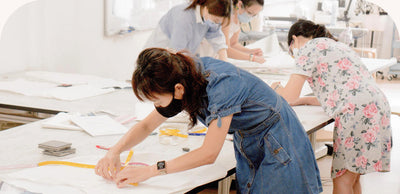
The Cheongsam - A Symbol of Women's Liberation
Cover: Maggie Cheung in "In the Mood for Love" (2000) directed by Wong Kar Wai.
The evolution of the cheongsam.
The Cheongsam - a trademark representation of Chinese culture that is gracefully don on by women of all ages, has a rich, long-standing history spanning over 300 years. Currently often represented as a fitted sheath dress with a rounded high collar, side slits and an overlap on the right side that is adorned by knotted buttons - this dress has come a long way and has seen the changing of dynasties and cultures.
Popular theory suggests that the cheongsam originated from the northeastern region of China in the early days, starting off as an everyday robe for the Manchurian men, women and children. Its style and structure was relatively simple, except that the thickness and material differed according to the change in season and temperature.
The early cheongsams were essentially loose-fitting robes draped with the overlap on the right side. They had long sleeves, slits on the sides of the body and a straight collar/hem with piping on the edges. As horseback riding and archery were a part of daily life, the garbs had to be loose to allow for active movement.

Bride and groom, wearing ornate Manchu wedding robes in the Qing Dynasty. Image: supchina
1875-1908, Guangxu Period:
With the integration of regional culture, the changes in the way of life and production during the Qing dynasty, the style of cheongsam gradually changed. The most common change were the sleeves of the women's cheongsam - they were widened. More attention was paid to adding decorative elements to details such as cuffs, necklines and plackets, mainly using embroidery.
After the Qing Dynasty in 1911, the women's cheongsam transformed into a straight sheath dress down to the ankle, and the collar resembles the ingot. This style camouflaged the relatively bulkier and stronger Manchu women body structure.
Later, only men of a certain social class and government officials were forced to dress in Manchu style. The male version was referred to as chángshān, which, incidentally, is how we acquired the english word "cheongsam" for the women's clothing (from the Cantonese word chèuhng sàam).
1920s:
The evolution of the cheongsam happened in the Republic of China during the 1920s. An institutional change, resulting from the period of the Nationalist government issuing Uniform Regulations that dictated the dress code for everyone. The cheongsam became a women's representation of their desire to liberate themselves and to promote gender equality. They adapted the men’s chángshān and transformed it into a plain cotton garment with loose-fitted bell sleeves that brought a lot of attention from around the world.

A Chinese woman in the 1920s. Image: unknown
Shanghai in particular was the gateway to the world. As it gradually opened up, with the influence of the western world - the one-piece dress for women which was popular with the western society, saw the evolving of the cheongsam from being worn with pants to becoming a 1-piece garment. The silhouette tightened and hugged the body closely, higher slits showed off the legs, decoration was reduced and more emphasis was given to the women’s curves. This gave the cheongsam the elegant and slimming fit that it’s known for today.
1930s:
In the 1930s, the cheongsam became the most popular women's clothing in society. The transformation of the cheongsam and variations also became more frequent. At first, high collars and then low collars became popular. When there was no way to go any lower, the collar was simply removed. The sleeves are sometimes longer than the wrist, or sometimes short and revealing. Ordinary cheongsams used hidden buttons for the opening of the cheongsam.

An advertisement for Coca Cola in Shanghai. Image: thatsmags
1940s:
Ten years later, the sleeveless cheongsam was introduced and the hemlines started to rise to just below the knees. The cheongsam of this period had fewer decorative elements but were more lightweight and fitted. It was still representative of China’s national dressing but also inculcated the active and progressive way of life for Chinese women.

Republican Era Portrait from Shanghai. Image: unknown

Shanghai film star, Ruan Lingyu. Image: Alamy, bbc

Film Actress, Hu Die, also known as Butterfly Wu. Image: unknown
1950s:
The main theme of society in the 1950s was production and construction. With a vast number of women in the workforce, the fitted cheongsam diminished in favour of more loose fitting shirts and pants for the more active women. The cheongsam evolved into a garment reserved for more important celebrations.

A woman in a Cheongsam in the 1960s. Image: unknown

1962 British Overseas Airways Corporation Air Stewardess Uniform. Image: Eternal1966
1980s:
It was not until the 1980s that the cheongsam returned to the public eye and gradually adapted to the change of the times and lifestyles.
However, the use of a tight-fitting design limits the range of motion of a woman's shoulders, compelling the body to maintain a vertical and upright posture. The cheongsam continues to create a graceful and dignified demeanour.
2000 and beyond:
In the famous movie "In the Mood for Love" (2000) directed by Wong Kar Wai, where Maggie Cheung wears the cheongsam, emanating grace in appearance and elegance in temperament, made the cheongsam even more sought after - even in the international community.

Maggie Cheung in "In the Mood for Love" (2000) directed by Wong Kar Wai.
A video about the cheongsams in famous movies like "In the Mood for Love" and "The World of Suzie Wong".
The skilled tailors of traditional cheongsams are now limited to a few in Shanghai and Hong Kong, but more variations have since surfaced. The contemporary cheongsam is now available in a range of designs, forms, and materials. These modern variations include cheongsams that defy the conventional body-hugging form with an A-line cut or flared skirt, cheongsam tops with pop art prints worn with Western-style skirts, pants, and jeans. There are also evening and bridal cheongsam dresses made from French lace, Italian silk, and more.

Grace Kelly winning the Golden Globe Award Image: beyondgracekelly
Despite these style updates, the modern cheongsam generally maintains its iconic look by retaining distinguishing elements like the mandarin collar, asymmetrical opening and side slits. The most popular times to wear these contemporary cheongsams are on important and festive occasions, like wedding dinners and Chinese New Year.
If you would like to read more about cheongsams, check out one of our students who has sewn countless cheongsams or this custom made cheongsam.
Sources:
https://eresources.nlb.gov.sg/infopedia/articles/SIP_2013-09-27_171732.html
旗袍的历史演变及其女性美的体现 by 赵晓玲 from晋城职业技术学院 (College in Jincheng, China)

